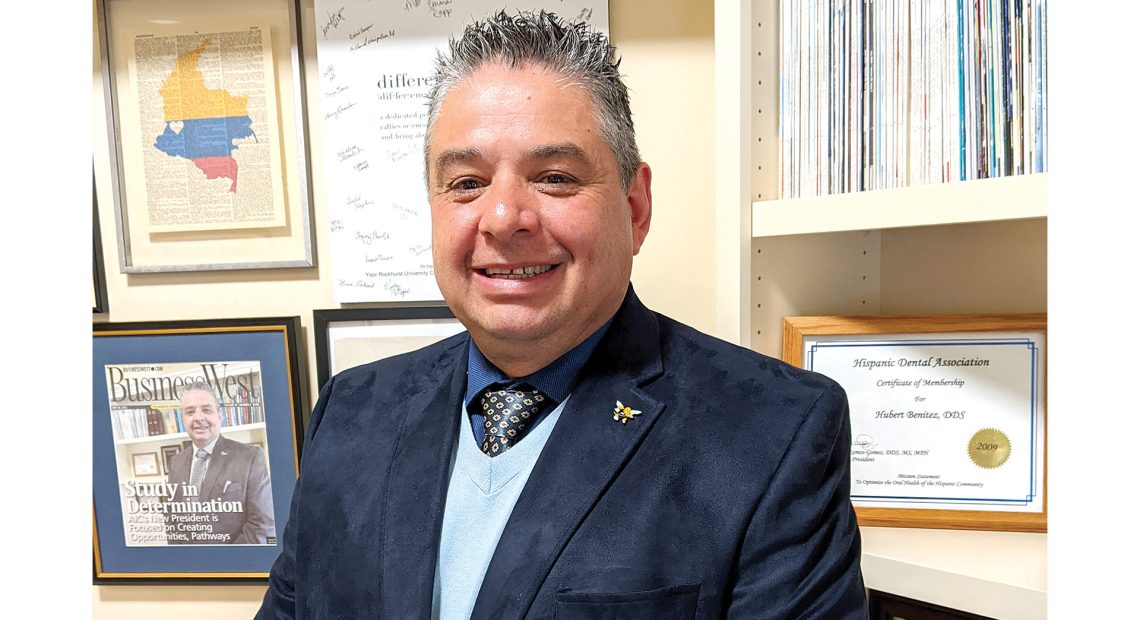It’s Not Simply Academic

Hubert Benitez says AIC strives to create a sense of belonging for students.
With high-school graduation numbers down in the U.S. and college enrollments following suit, Hubert Benitez says higher-education institutions must take a multi-pronged approach to enrollment management and their “overarching value proposition.”
“The academic portfolio of all our institutions across the region are very strong. So the students have options: wherever they will go, they will receive a sound education,” said Benitez, who began his tenure as president of American International College (AIC) last spring. “So, having said that, what truly differentiates one college from another?”
To answer that question, he pointed to a report called “AIC Reimagined 2022-2027,” which considers how to rethink strategies in six different pillars, including academics; student life, engagement, and support; fiscal growth; internal and external community engagement and development; diversity, equity, inclusion, and belonging, and athletics.
Take the first pillar, academics. “We realized, post-pandemic, that we have to reimagine our academic enterprise and what the collegiate experience is all about,” Benitez told BusinessWest. “We have to rethink how we offer education. Students learn differently, and they want to attend college in a different way. We have a lot of non-traditional students coming back to education, people who, post-pandemic, want to retool themselves for a career change — adult learners, students who have family commitments. If we are to address their needs, we really have to rethink how we offer our academic portfolio.”
Colleges and universities everywhere are having similar conversations about how to attract, and then shepherd to graduation, a smaller pool of potential college students than in past decades, due largely to changing demographics.
“The return-on-investment case has been made over and over again. The economics have been quite clear for a long time: people with a college degree earn over a million dollars more over their lifetime than those who don’t have one.”
According to the National Student Clearinghouse Research Center, undergraduate enrollment at U.S. colleges fell by 1.1% in fall 2022 compared to 2021, a pace of decline that’s nearly returned to pre-pandemic rates. In between was a year, 2020, when enrollment dropped 3.4%, followed by 2.1% in 2021. The net effect of those years is an enrollment total that’s down close to 7% from 2019.
“The trend for higher-education enrollment had been on the decline, but this was certainly exacerbated by the pandemic years,” Elms College President Harry Dumay said. “But things are coming somewhat back to normal these days for us.”
That’s reflected in some healthy numbers for Elms’ various segments, including first-time freshmen, traditional transfer students, and especially graduate students; the only segment that has seen some erosion is transfers from community colleges, which were hit hard by the pandemic.
A stabilization of enrollment makes sense, despite the high cost of college, Dumay said. “The return-on-investment case has been made over and over again. The economics have been quite clear for a long time: people with a college degree earn over a million dollars more over their lifetime than those who don’t have one.”
What Elms and many other schools are now doing is providing more flexibility for adult and non-traditional students, such as stackable, short-term certificates that ease the way to gainful employment and accumulate toward a degree down the line.
However, he noted, beyond the economics, what shouldn’t be undervalued is the formative aspect of college, especially for the shrinking 18-22 age demographic. “Whether you go full-time or part-time, whether residential or commuter, there is something that happens in those years — forming character, learning to think critically — which affects the value.”
Benitez said culture is a key element of AIC’s message to prospective students and their parents.
“One differentiator is how we create a sense of belonging for the students. It’s very important to today’s students,” he explained. “When they arrive on campus, they need to feel like they belong. I truly believe AIC provides that value to any student from any background because we have intentionally created an environment where every single student feels like they belong.”
Once enrolled, he added, “we follow the student along their educational journey, providing support services at every single stage of their academic journey.”
“If any students are struggling for any reason that would keep them from persisting and staying enrolled at college, we have a whole team dedicated to helping them work through that.”

Darcey Kemp
In fact, that’s a key element of one of the six pillars, and it’s important, especially for first-generation college students, to have the peace of mind offered by such supports.
“For a parent who did not have the opportunity to attend college, leaving his or her child in an environment where they don’t know if they’re going to feel right has to be daunting,” Benitez said. “We try to approach parents and students alike, making them understand that’s important to us. I hope they are relieved when they come here and feel the caring environment.”
Support System
Springfield Technical Community College (STCC), whose enrollment figures are up slightly from last spring, is also heavily focused on culture and student support, said Darcey Kemp, vice president of Student Affairs.
“There’s no one-size-fits-all approach,” she added. “Our students are individuals, with individual experiences.”
The support starts early, with outreach to high-school students to help them with applications, placement testing, financial aid, choosing class schedules, and more. “We come to you,” Kemp said, noting that STCC also invites guidance counselors to campus so they can gather information to bring back to their schools.
Aware of the impact the pandemic had on men of color, who dropped out disproportionately during that period, STCC also created the Male Initiative for Leadership and Education (MILE), a program that provides inclusive academic support, mentoring, and community-engagement opportunities to male students, particularly Black and Latino students. Participants connect with professionals who serve as mentors throughout the student’s time at the college, helping them stay on track to reach their degree goals.
That can be a challenge at many institutions. The Education Data Initiative reports that first-time undergraduate freshmen have a 12-month dropout rate of 24%. Among first-time students in bachelor’s-degree programs, almost 26% do not earn their degree; among all undergraduate students, around 40% drop out.
The economic impact can be significant; the same report notes that college dropouts make an average of 33% less income than those who hold bachelor’s degrees, and college dropouts are almost 20% more likely to be unemployed than any degree holder.
That’s why student advisors at STCC work closely with students to make sure they’re taking the classes they need to achieve their degree goals, and why the college regularly looks back five semesters and reaches out to anyone who has paused their education and not returned during those two and a half years, to talk about what supports they might need to continue, and what steps to take to re-enroll.
“We need, in higher education in general, to invest time and energy into resources that help students reach their personal and academic goals,” Kemp said. “It’s an individualized conversation for each student.”
Dumay said 44% of Elms students are Pell-eligible, meaning they come from low-income families, so it’s important that they succeed. “You don’t want to come to Elms and not graduate, whether with debt or without debt, because of the investment of time. It’s really important we help our students graduate.”
With a student graduation rate and a first-year retention rate higher than the national average, that effort has paid off, he added. “There are a variety of things we put in place to ensure we help students be successful, including a physical Center for Student Access, but also supports like coaching.”
Benitez said 50% of AIC’s student body is Pell-eligible, and many are the first in their family to attend college. “We have a number of programs for first-generation college students that include very basic things like time management, how do you learn, how do you study, how to you financially plan? This is often new to them, so helping them navigate their college experience is very important to us.”
STCC’s Center for Access Services helps students tackle issues such as homelessness and food insecurity that could hinder their ability to get an education and climb the economic ladder.
“If any students are struggling for any reason that would keep them from persisting and staying enrolled at college, we have a whole team dedicated to helping them work through that,” said Kemp, adding that the STCC website also has a ‘chat now’ feature for student questions on anything from admissions to financial aid to understanding the Blackboard learning-management system. “It’s another way to demonstrate to students that we will engage with them in any way they want to engage with us.”
Rolling with the Changes
In short, Kemp said, “it’s important that we continue to share with students that there are opportunities to manage all the things they have going on. If a working parent wants to go to college, they can; they don’t have to choose between taking care of the family and obtaining a degree.”
That proposition is easier now, she added, with the program flexibility — in person, hybrid, or fully online — that emerged during the pandemic.
Benitez believes academic institutions today need to serve as engines for workforce development, and in AIC’s case, the impact is local, as most of its students hail from the region, and many stay and work here after graduation.
“We ask our business partners, what do you need in a graduate? What is the skillset, the competency set? And how are we going to revise and reimagine our academic offerings so it’s responsive to the workforce needs of this region?”
Because young people today plan to change jobs many times, one role of colleges is to teach them to be lifetime learners, he added, so they can easily adapt to their changing environment; in some cases, they’re training for jobs that don’t even exist yet. “We should prepare the groundwork for them to learn as they grow,” Benitez said.
Dumay told BusinessWest that the past few years have been a difficult time for all colleges, one in which they’ve had to be prudent financially. But he believes those efforts to tighten up and adapt are worth it.
“We’re providing a tremendous service to the general public — not just Elms, but all colleges like us — by helping the citizenry, both young people and not so young, get a foot on the economic ladder. That benefits all of us,” he said.
“If higher education struggles, the entire economy struggles,” he went on. “We are certainly staying strong, and the help that has been provided by the federal and state government helped a lot of colleges remain strong. But it is still a challenging time for higher education, and we want to remain healthy and strong so we can serve our students.”
To do that, Benitez said, requires a willingness to do things differently — in other words, to reimagine a college education. He believes the alternative, stagnation, is unsustainable.
“Academic institutions must be able to adapt to the current times, to meet the student where they are,” he said. “That’s critically important in these times.”









